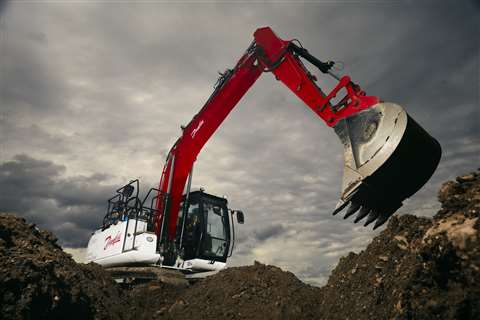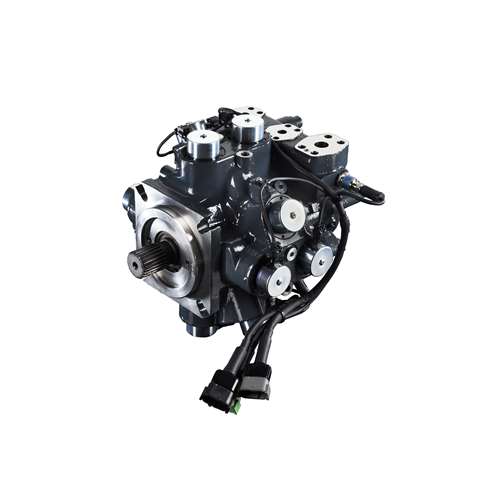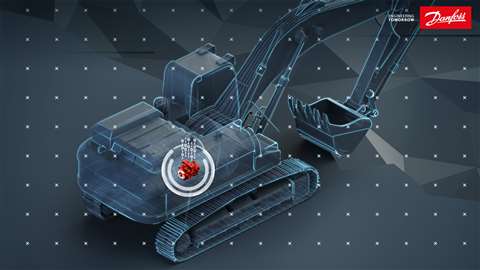Danfoss Q&A: Technology to reduce excavator energy consumption
17 February 2023
New research from Danfoss claims that combining an electric motor with one of the company’s digital displacement pumps in an excavator is the most efficient way to turn battery energy into hydraulic work.
 Danfoss is making bold energy reduction claims for its digital displacement pump technology. Photo: Danfoss
Danfoss is making bold energy reduction claims for its digital displacement pump technology. Photo: Danfoss
The The Denmark-headquartered fluid power and electrification specialist says the combination can reduce the energy required for a typical day’s work, and therefore the battery size, by nearly 25%.
Construction Europe spoke with Leif Bruhn, head of digital displacement at Danfoss Power Solutions, to discuss the implications of these findings.
Put this research into context for us. Why excavators? Why the focus on energy efficiency?
Excavators account for 50% of all carbon dioxide emissions generated by construction machinery, with 200 megatonnes released annually by excavators alone. Around 90% of those emissions come from machines in the 10-ton and larger size range. At the same time, today’s excavators are only 30% efficient. Around 70% of the engine’s energy is wasted as heat in the hydraulic system.
At Danfoss, we believe that improving excavator efficiency is the first step in reducing the carbon impact of the construction sector. The efficiency of the hydraulic system and using the control benefits of Digital Displacement enables excavators to deliver the same amount of work either with a smaller engine and less fuel or doing more work with the same size engine.
What sort of testing did you do and how did you validate the results?
Readers are welcome to peruse our full research report. To summarise, we developed a simulation model of a 16-tonne tracked excavator and calculated the energy requirements for a typical eight-hour shift. It compared a base case of an electric machine equipped with a conventional swash plate pump versus an excavator with an electric drive and Dextreme Swap system.
 Danfoss’ digital displacement pump. Image: Danfoss
Danfoss’ digital displacement pump. Image: Danfoss
The results showed that, depending on system complexity and duty cycle, a reduction in energy requirement of up to 24.8% can be achieved. The improved system would require a 314-kWh battery for an eight-hour shift compared to a 418-kWh battery in the base case.
The study was supported by the Advanced Propulsion Centre UK and verified by Bureau Veritas.
How does the technology produce this level of energy savings and how does it differ from a typical hydraulic pump?
The digital displacement pump is the core component of the Danfoss Dextreme system solution we recently introduced.
Specifically designed for medium and large excavators, Dextreme systems dramatically improve the system efficiency of excavators, whatever the power source, lowering energy consumption while maximising productivity.
With the Dextreme system, our priority is to help our customers radically reduce emissions, lower energy consumption, improve productivity, and reduce total cost of ownership.
The digital displacement pump was the first and remains the only truly digitally controlled pump for hydraulic off-highway machinery. It is controlled using a digital controller that activates each piston individually, providing fast and accurate control response to system demand.
 An illustration of Danfoss’ digital displacement pump installed in an excavator. Image: Danfoss
An illustration of Danfoss’ digital displacement pump installed in an excavator. Image: Danfoss
This results in unmatched full and partial load efficiency. Furthermore, it can perform as a multi-outlet pump, with each outlet independently controlled by the digital controller.
This results in an incredibly fast response time and superior controllability.
Is this technology market-ready? Are any OEMs using it on production machines?
While I can’t speak to the discussions we’re having with specific OEMs, I can tell you we are piloting the technology with strategic customers in the UK and US. In addition, we’re conducting a 12-month field trial of three 20-tonne excavators with a major quarry operator in the UK.
Each machine is equipped with a Dextreme Swap system, along with data logging equipment to enable direct comparison with the operator’s standard excavators of the same model.
We will be capturing data throughout the trial to measure performance and efficiency.
The early feedback we’ve received has been overwhelmingly positive. The company’s operators report that the machines equipped with the Dextreme system feel more responsive and powerful.
Is 25% energy savings the limit?
 Danfoss Power Solutions’ head of digital displacement, Leif Bruhn. Photo: Danfoss
Danfoss Power Solutions’ head of digital displacement, Leif Bruhn. Photo: Danfoss
In our study, we combined a digital displacement pump with a Danfoss Editron electric motor and inverter, which produced 25% energy savings. That’s one way to achieve greater efficiency, but it’s important to emphasise that our Dextreme system works with any type of excavator: conventional, hybrid, or electric.
With our Dextreme system solutions pathway, we can scale from 15% savings up to 50% energy savings while also increasing productivity.
The simplest configuration of the system is what we’ve dubbed Dextreme Swap, available today, which involves a simple replacement of the excavator’s hydraulic pump. With this system, we’re able to deliver a 15% reduction in fuel use and CO2 emissions by reducing losses in the main pump.
Dextreme Flex, the next step after Swap, delivers a 30% reduction in fuel use and emissions. This system introduces flexible flow output, which results in significantly reduced system losses.
Finally, we predict our Dextreme Max system will generate a 50% reduction in fuel use and emissions. This level of savings will be possible through energy recovery and by controlling hydraulic loads directly from the pump, cutting throttling losses in the main control valve.
How do you see this technology rolling out?
Globally, we’re seeing regulations demanding low- or zero-emission machines in densely populated areas.
The Danfoss Dextreme system is fully aligned with these trends. It’s producing scalable efficiency improvements today, regardless of the machine’s power source. And for diesel-powered excavators, it’s providing a clear pathway to electrification.
Long term, an excavator utilising a Dextreme system will have a lower total cost of ownership than a standard diesel machine. In addition, we estimate that Dextreme systems can deliver up to 25% higher productivity.
POWER SOURCING GUIDE
The trusted reference and buyer’s guide for 83 years
The original “desktop search engine,” guiding nearly 10,000 users in more than 90 countries it is the primary reference for specifications and details on all the components that go into engine systems.
Visit Now
STAY CONNECTED




Receive the information you need when you need it through our world-leading magazines, newsletters and daily briefings.
CONNECT WITH THE TEAM









